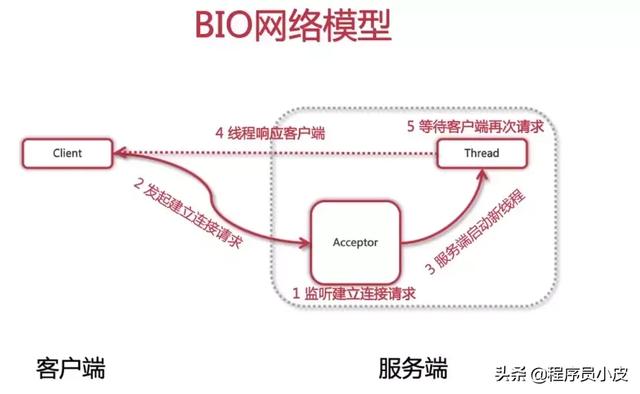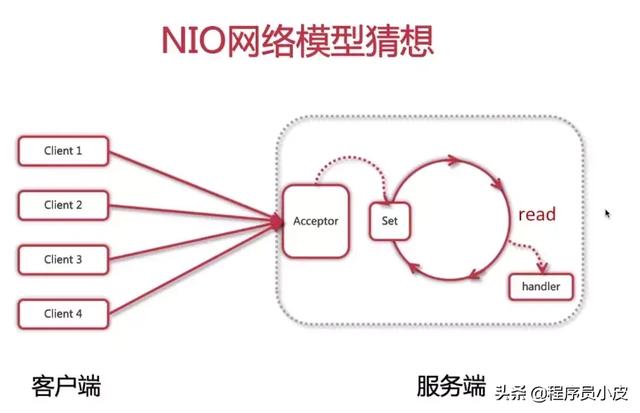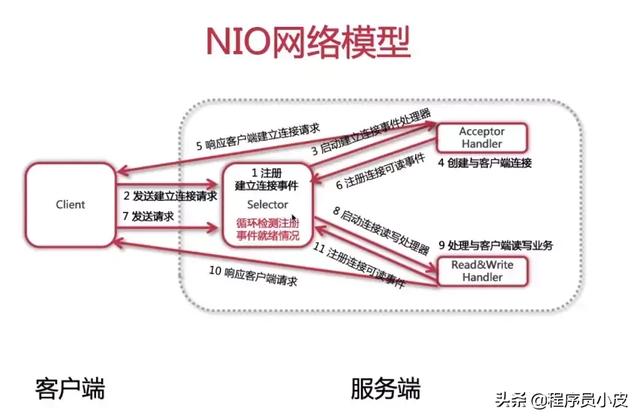New I/O
回顾BIO编程模型


服务端对于每个到达的客户端都重新开启一个 线程 专门处理它们之间的交互。 这种交互在逻辑上是客户端与服务端直接进行通信。 随着高并发的场景到来,服务器处理上下文切换,创建和销毁线程的代价,将会让服务器不堪重负。
NIO编程模型构想

NIO in JAVA

Channel –> 区别于单向的InputStream/OutputStream,它是双向的。 Selector –> 主要的控制器 Buffer –> 读写两种模式可以通过flip切换。
多人聊天室实战
Server 服务端
启动方法
ServerSocketChannel先创建,后绑定一个端口。 设置为非阻塞模式。 将channel注册到selector上,监听连接事件。 开始循环等待新接入的连接。
循环内: 每次调用selector.select()将会阻塞地等待至少一个channel准备就绪,返回准备就绪地channel数量。 如果数量为零,开始下一轮select(); 数量不为零,则将这些准备就绪地channel取出来。 根据这些channel对应的当初向selector注册的类型( accept /read),执行对应的业务逻辑。
public void start() throws IOException {
Selector selector = Selector. open ();
ServerSocketChannel serverSocketChannel = ServerSocketChannel.open();
serverSocketChannel.bind(new InetSocketAddress(8000));
serverSocketChannel.configureBlocking(false);
serverSocketChannel.register(selector, SelectionKey.OP_ACCEPT);
System.out.println("服务器启动成功!");
for (;;) {
int readyChannels = selector.select();
if (readyChannels == 0) continue;
Set<SelectionKey> selectionKeys = selector.selectedKeys();
iterator iterator = selectionKeys.iterator();
while (iterator.hasNext()) {
SelectionKey selectionKey = (SelectionKey) iterator.next();
if (selectionKey.isAcceptable()) {
acceptHandler(serverSocketChannel, selector);
}
if (selectionKey.isReadable()) {
readHandler(selectionKey, selector);
}
}
}
}
连接建立处理
建立连接成功后,设置非阻塞模式,并且将这个刚刚建立的channel,注册到服务端的Selector。
private void acceptHandler(ServerSocketChannel serverSocketChannel,
Selector selector)
throws IOException {
SocketChannel socketChannel = serverSocketChannel.accept();
socketChannel.configureBlocking(false);
socketChannel.register(selector, SelectionKey.OP_READ);
socketChannel.write(Charset.forName("UTF-8")
.encode("你与聊天室里其他人都不是朋友关系,请注意隐私安全"));
}
消息读取处理
private void readHandler(SelectionKey selectionKey, Selector selector)
throws IOException {
SocketChannel socketChannel = (SocketChannel) selectionKey.channel();
ByteBuffer byteBuffer = ByteBuffer.allocate(1024);
String request = "";
while (socketChannel.read(byteBuffer) > 0) {
byteBuffer.flip();
request += Charset.forName("UTF-8").decode(byteBuffer);
}
// 将channel再次注册到selector上,监听他的可读事件
socketChannel.register(selector, SelectionKey.OP_READ);
if (request.length() > 0) {
broadCast(selector, socketChannel, request);
}
}
消息广播
private void broadCast(Selector selector,
SocketChannel sourceChannel, String request) {
// 获取到所有已经接入的客户端channel
Set<SelectionKey> selectionKeySet = selector.keys();
selectionKeySet.forEach(selectionKey -> {
Channel targetChannel = selectionKey.channel();
// 剔除发消息的客户端
if (targetChannel instanceof SocketChannel
&& targetChannel != sourceChannel) {
try {
// 将信息发送到targetChannel客户端
((SocketChannel) targetChannel).write(
Charset.forName("UTF-8").encode(request));
} catch (IOException e) {
e.printStackTrace();
}
}
});
}
Client 客户端
启动方法
public void start(String nickname) throws IOException {
SocketChannel socketChannel = SocketChannel.open(
new InetSocketAddress("127.0.0.1", 8000));
Selector selector = Selector.open();
socketChannel.configureBlocking(false);
socketChannel.register(selector, SelectionKey.OP_READ);
//开启一个线程专门处理服务端发来的消息
new Thread(new NioClientHandler(selector)).start();
//向服务端发送消息
Scanner scanner = new Scanner(System.in);
while (scanner.hasNextLine()) {
String request = scanner.nextLine();
if (request != null && request.length() > 0) {
socketChannel.write(
Charset.forName("UTF-8")
.encode(nickname + " : " + request));
}
}
}
处理服务端消息
与服务端的start方法类似。 但客户端的Selector只注册了一个读事件的SocketChannel。 因此该Selector,实际上就只是不断地监听服务端有没有消息传过来。 如果有消息传来那么该Selector中绑定的这个唯一的channel就会编程已经就绪的状态,将会执行它的readHadler()。 所以客户端使用NIO和BIO的性能影响差别不大。
@Override
public void run() {
try {
for (;;) {
int readyChannels = selector.select();
if (readyChannels == 0) continue;
Set<SelectionKey> selectionKeys = selector.selectedKeys();
Iterator iterator = selectionKeys.iterator();
while (iterator.hasNext()) {
SelectionKey selectionKey = (SelectionKey) iterator.next();
if (selectionKey.isReadable()) {
readHandler(selectionKey, selector);
}
}
}
} catch (IOException e) {
e.printStackTrace();
}
}
readHandler
private void readHandler(SelectionKey selectionKey, Selector selector)
throws IOException {
SocketChannel socketChannel = (SocketChannel) selectionKey.channel();
ByteBuffer byteBuffer = ByteBuffer.allocate(1024);
String response = "";
while (socketChannel.read(byteBuffer) > 0) {
byteBuffer.flip();
response += Charset.forName("UTF-8").decode(byteBuffer);
}
socketChannel.register(selector, SelectionKey.OP_READ);
if (response.length() > 0) {
System.out.println(response);
}
}
最后,我自己是一名从事了多年开发的JAVA老程序员,辞职目前在做自己的java私人定制课程,今年年初我花了一个月整理了一份最适合2019年学习的java学习干货,可以送给每一位喜欢java的小伙伴,想要获取的可以关注我的头条号并在后台私信我: 交流 ,即可免费获取。



